Thomas William Johnson
Private 27001 Thomas William Johnson, 1st/8th (Territorial) Battalion, Hampshire Regiment
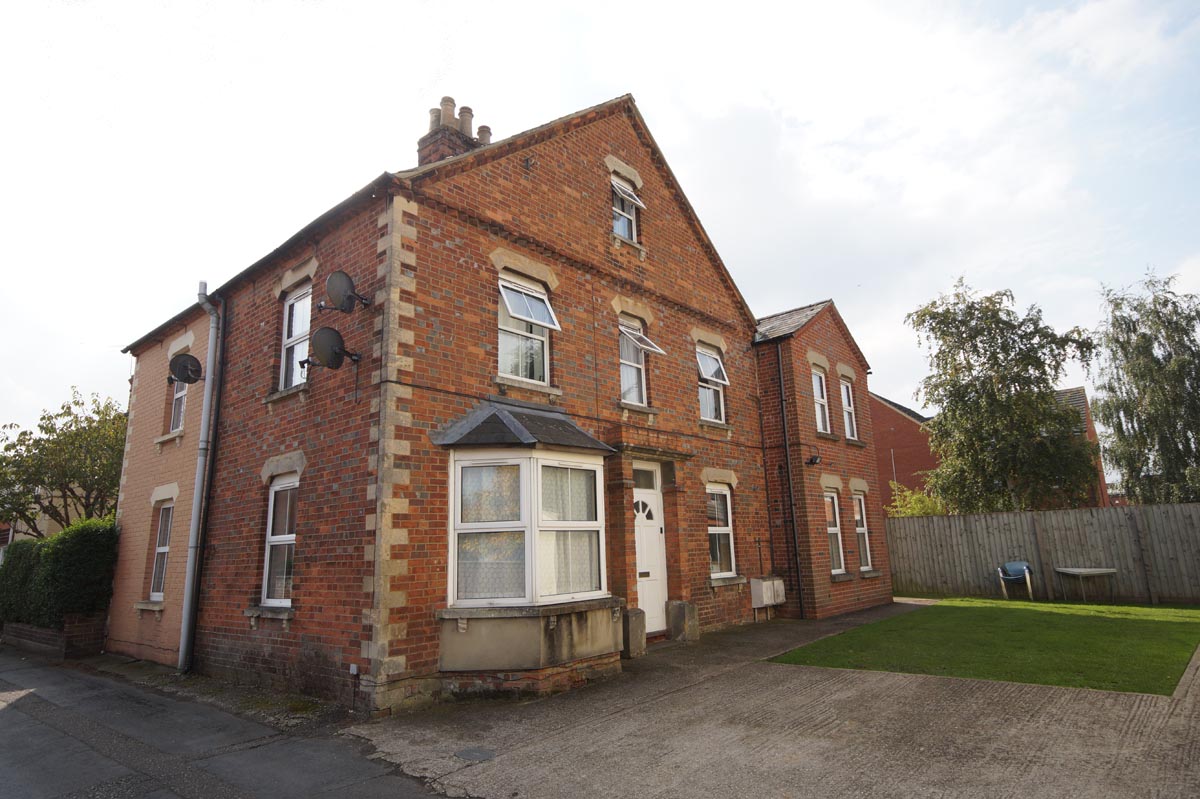
7 Livingstone Road - 1 Hampton Villas during WWI, when it was home to the Johnson family. |
By the time of the 1911 census George and Jane eight surviving children: Maud (by then Mrs Alfred Carter), George, Charles Frank (born 1890), James Thomas (1893), Thomas, William Robert (1899), Lilian May (1902) and Gladys (1906).
Thomas was educated for a time at the British School in Newbury before transferring to St Nicolas National School on 8 April 1907; on the same day his brother William entered St Nic’s from St John’s infant school. Their sojourn at St Nic’s was very short – both left after fewer than three weeks. The school register gives no reason for their departure which is unusual. The obvious reason that the family left town does not appear to apply; street directories have them living in the same house (4 Beauchamps Cottages, York Road) from 1906 to 1909. They may well have transferred to the British School, both were still in school at the time of the 1911 census.
From 1910 to 1913 they were at 2 Barnes Villas, York Road, this was designated as no 65 when the street was numbered during their time there (their previous home became no 16 – prior to that they had lived at no 14). In 1913 they moved again, to 1 Hampton Villas, Livingstone Road (now no 7).
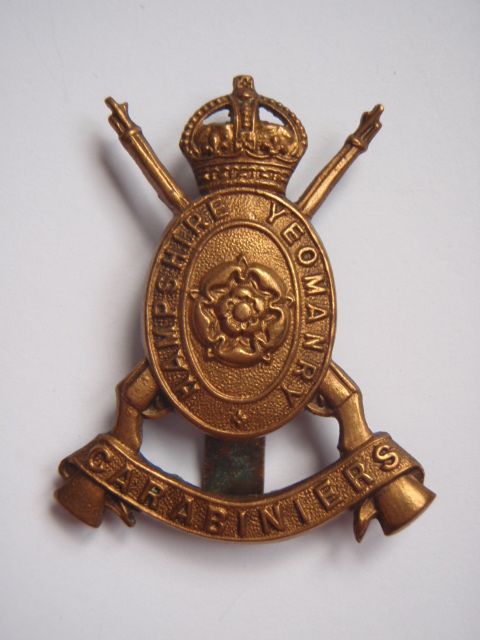
The regimental cap badge of the Hampshire Yeomanry. |
After training Thomas was sent to France, either when the 1st/1st Hampshire Carabiniers went as a unit in June 1916 (by which time Thomas was over 19), or as a replacement in the ensuing months. In France the regiment was mainly used as XI Corps cavalry – but Harry did not stay with the regiment; at some point he was transferred to the infantry, specifically to the 15th (Service) Battalion, Hampshire Regiment (regimental number 27001). Another Newbury soldier (Harry Shaw) was also transferred in the same period, suggesting that the Carabiniers were being used as a source of trained replacements to the 15th Hampshires. Shortly before his death the remaining 1/1 Hampshire Carabiniers were transferred en masse to the same battalion, which then adopted the name 15th (Hampshire Yeomanry) Battalion.
However, Thomas was no longer with the battalion; at some point he was invalided home suffering from trench fever (now known to have been a bacterial infection, but then it was a mystery disease). When he recovered he was posted overseas again, but this time to join the 1st/8th (Territorial) Battalion, Hampshire Regiment in Egypt/Palestine – this battalion also had an alternative name: Princess Beatrice's Isle of Wight Rifles.
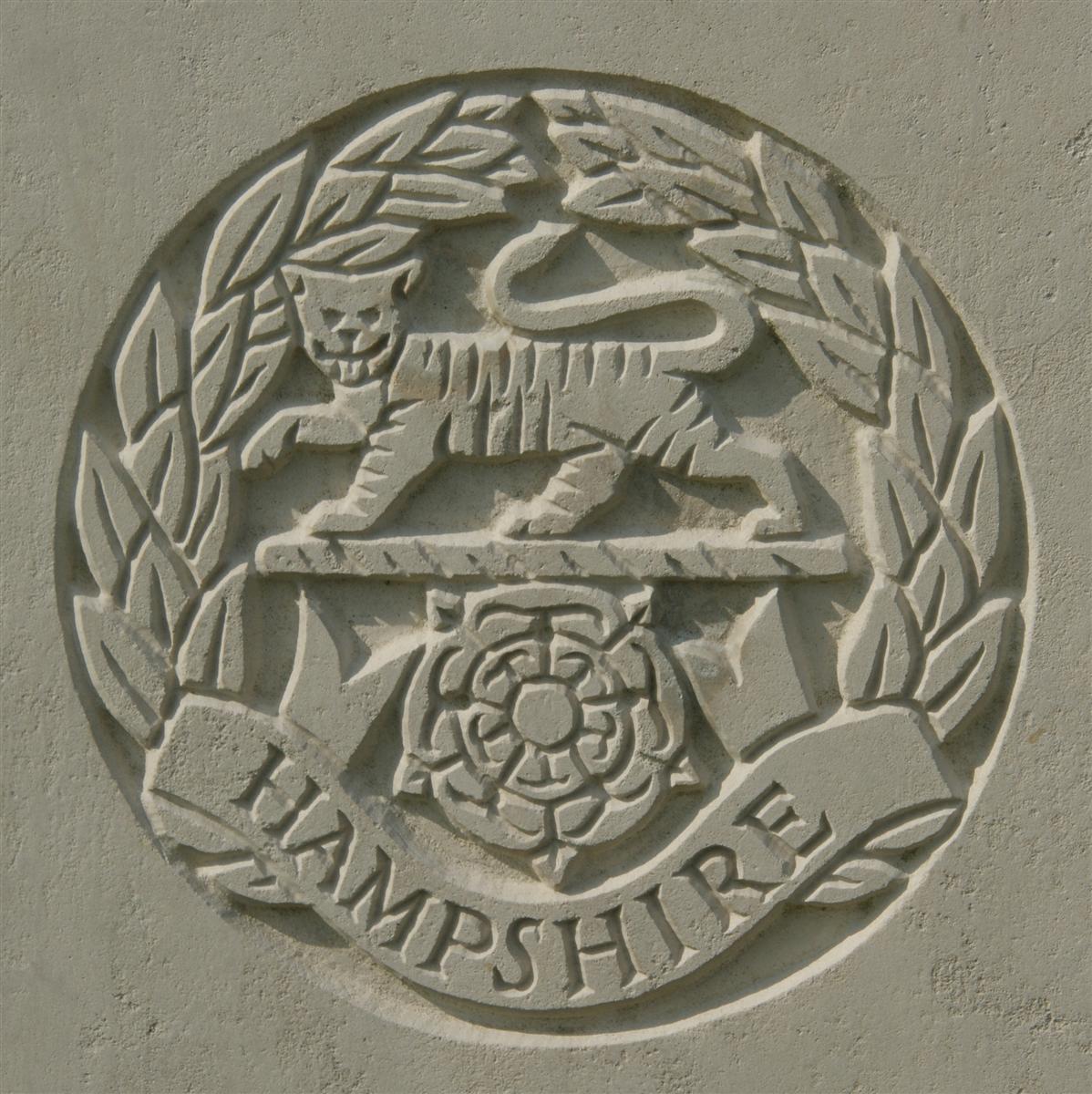
The regimental badge of the Hampshire Regiment, as used on CWGC headstones. |
The battalion had served in Gallipoli before moving to Egypt as a part of the Egyption Expedicitonary Force or EEF. The EEF moved against the Turkish forces in the Sinai that offered a threat, albeit only a small one, against the Suez Canal. By March 1917 the EEF had reached Gaza, the gateway to Palestine and beyond. Two attempts to dislodge the Turkish and German defenders in March and April failed, which led to the sacking of EEF commander, Lt Gen Sir Archibald Murray and his replacement by Gen Edmund Allenby (later Field Marshall Viscount Allenby). Allenby prepared for a third attempt on Gaza, which eventually started on 31 October 1917 with a flanking assault on Beersheba.
On the night of the 1/2 November 1917 the EEF assaulted the Gaza defences – sadly Thomas was one of the casualties. It is often difficult to determine when a man received his fatal wounds, after all death could be hours or weeks after the event during which time his unit may have been in harm’s way on several occasions losing more men to wounds. In Thomas’s case it seems probable (though by no means certain) that he succumbed quickly to wounds received in the early hours of the day of his death.
The battle was a turning point in the campaign, casting aside the embarrassing defeats in the first two battles the Turkish defences were overcome and the way was open towards Jerusalem (which Allenby entered on foot on 11 December) and Damascus. However, there were localised setbacks – including the action involving the 1/8th Hants.
The 54th Division was tasked with an assault on the Turkish defences to the south-west of Gaza; the 163rd Brigade’s objectives are shown in a detailed trench map that has survived in the 1/8th Hants’ war diary. Sadly things did not go entirely to plan as the battalion detailed diary entry makes clear:
War Diary, 1st/8th Battalion, Hampshire Regiment – 2 November 1917
0130 All troops in correct position
0200 Battn in position at Forming-up Place. At this period enemy opened a moderate rifle and MG fire.
0230 Battn in position at Halfway House – some ten casualties having occurred through enemy rifle and MG fire.
0300 Zero hour – Assaulting troops advanced from Halfway House to the capture of enemy positions.
0305 Very heavy enemy barrage composed of HE, shrapnel and minenverfer shells put down on a line parallel to & 100x from enemy front line positions. The barrage caught the right assaulting Coy (A Coy) and the two Coys comprising the 2nd wave (B & D Coys) the consequent confusion causing a loss of direction. The two right platoons of A Coy & the signalling forward command party bearing off half right & assaulting, and capturing TRIANGLE TRENCH (this being one of the objectives of the 5th Suffolk Regt) – there a gun and 35 prisoners were taken. The remainder of the first wave (4 platoons C Coy – 2 platoons A Coy) proceeded on their correct bearing & were in position at 0310, when our artillery barrage lifted from the enemy front line trenches at BURJ, outside enemy front line wire.
0320 BURJ redoubt was captured with but little opposition & the 1st wave proceeded to further objectives in MARTHA & ELLEN.
0335 The 2nd wave comprised of B & D Coys entrench enemy from line trenches beteen BURJ & ZOWAID redoubts. 0325 – these were found to be cleared of the enemy. Some 10 dead & wounded Turks only remaining.
0340 The front wave finding both MARTHA & ELLEN untenable owing to enfilade fire from GIBRALTER & CRESTED ROCK & the fact that both of these trenches were mere scoops in the sand with neither parapet or parados proceeded to join B & D Coys garrisoning line BURJ-ZOWAID.
0355 Parties of 5th Norfolk Regt passed through to the capture of GIBRALTER & ZOWAID COPSE. These parties however, although gaining their objectives, in view of the fact that no communication trenches existed between line VIOLET-BURJ-ZOWAID, were obliged to withdraw and strengthen garrison holding the line.
0400 Consolidation of the above lin e in progress. Trenches found to be in a very bad condition – no parados & open to view from Turkish positions GIBARISH RIDGE, GIBRALTAR & CRESTED ROCK (which the Turks re-occupied on finding then vacated).
0545 Contact aeroplanes over the line – Flares were lit.
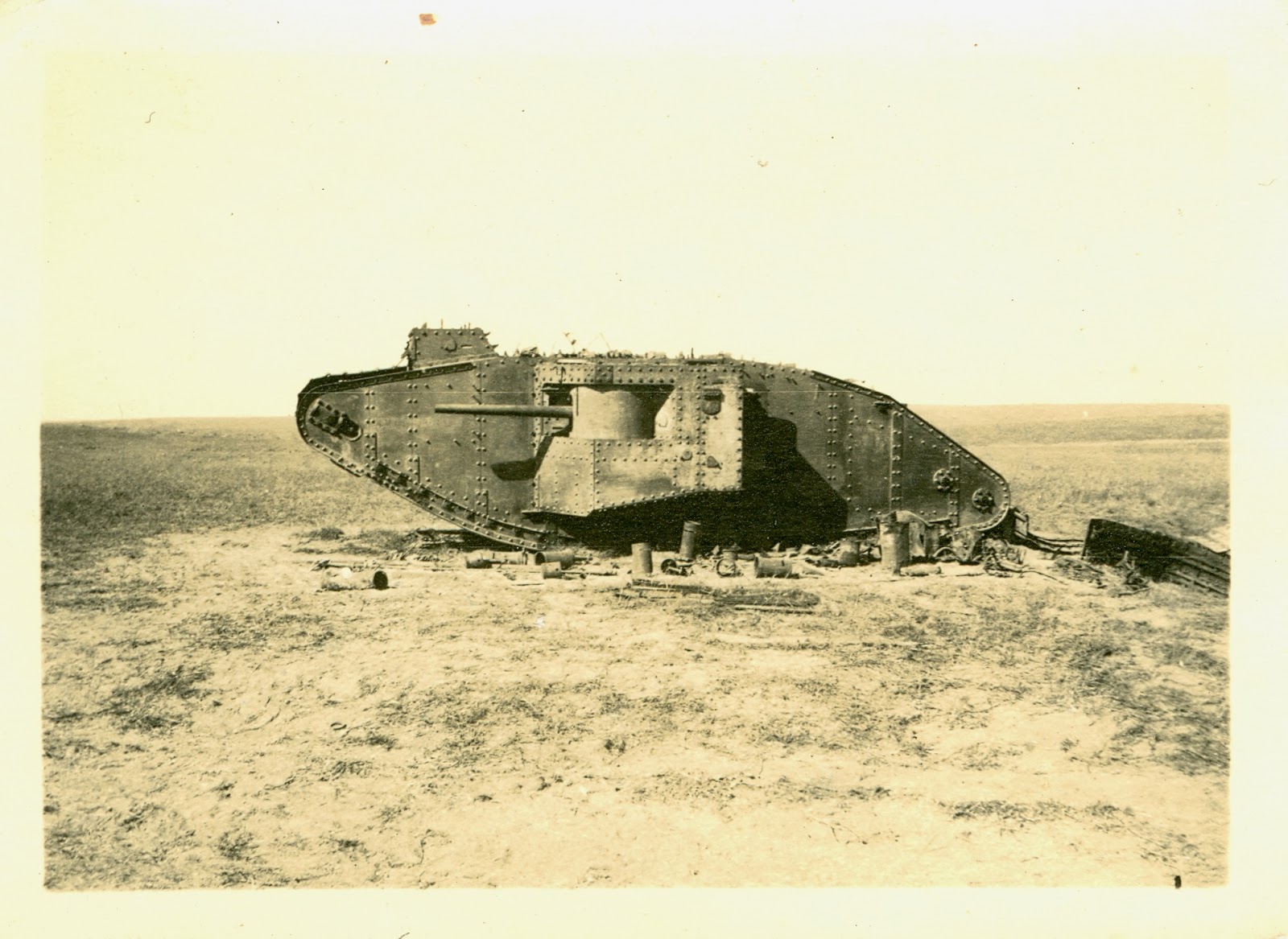
Tank disabled at the 3rd Battle of Gaza. |
1500 Instructions (per runner) received from HQ 163 Bde to the effect that line now held was to be consolidated and held at all costs.
1535 Wire of congratulation from Commander in Chief.
1700 Evening Stand to – By this time the ordinary trench routine had been reorganised – Bays numbered and garrisons detailed sentry groups posted – Ammunition (at first very low but now at the rate of 150rds per man owing to the efforts of carrying parties who all day long brought up supplies from YEOMANRY TRENCH under heavy sniping) & bombs issued – Lewis Gun positions made & manned. At dusk the two Platoons of A Coy (who had remained all day in TRIANGLE TRENCH) & the signalling forward command post rejoined Battn & lines were laid laterally to the Bde Forward Command Post.
2300 Our artillery opened heavy bombardment on Turkish positions – The enemy were apparently under the impression that an attack was to be launched on their positions & opened heavy artillery bombardment & MG & rifle fire Firing very high & erratic – no casualties.
Casualties from 2400 1/11/17 to 2400 2/11/17 – Killed in action: Capt L R COKE, 2nd Lieut F J POULTON & 51 Other ranks. Wounded: Capt R J SCARBOROUGH, Lieut A B CROSS, 2nd Lieut M R RYCROFT, 2nd Lieut T WALLACE & 123 Other ranks.
In essence this tells a tale of partial success – the enemy’s front line is taken and held, but objectives beyond this while being captured temporarily and soon surrendered back to Turkish control. The Official History lays the blame partly on the overcast weather (resulting in a lack of moonlight), the dust cloud raised by the enemy barrage, and the right flank of the Hampshires getting lost and confusing the 5th Suffolks attacking alongside them. It has to be said that confusion exists in the war diary as well – Ellen Trench named in the diary was nowhere near them, the diarist confused it with Ethel and Edna Trenches which lay between the front line and Martha Trench.
It seems likely that Thomas was one of the 123 ‘other ranks’ listed as wounded and died later that day at a first aid post or field ambulance.
The news of his death took some time to reach his family in Newbury, who announced it in the local newspaper’s Family Notices column:
Newbury Weekly News, 10 January 1918 – Died of Wounds
Pte T Johnson, No 27,001, Hants Regiment, died of wounds in Palestine, 2nd November, 1917, beloved son of Widow J Johnson, Bartholomew-street, Newbury, - aged 20 years.
He fought for the cause of justice,
From duty he never turned back;
Bravely he faced the cannons’ roar
And died ‘neath the Union Jack.
From his loving Mother, Sisters and Brothers
More details were printed in the regular column for news of Newbury’s men in uniform:
Newbury Weekly News, 10 January 1918 – Local War Notes
Pte F [sic] Johnson, Hants Regt., son of Mrs J Johnson, widow, of Bartholomew-street, who died of wounds in Palestine, on November 2nd, enlisted at the age of 18 in the Hants Yeomanry, and was transferred to the infantry. He was sent home from France suffering from trench fever, and on recovery was ordered to Egypt. Mrs Johnson has lost her eldest son, Pte G Johnson, Royal Scots, who had served eight years in India, and was reported missing at Mons. Another son, Lce-Corporal C Johnson, Royal Scots Fusiliers, who had served in India and Africa, was wounded in France and is now discharged. There is a son in the Berks Yeomanry, who survived Gallipoli, and is now in the Camel Corps in Egypt. The youngest boy at 17 enlisted in the RAMC, and is awaiting orders for the front. Truly a splendid record.
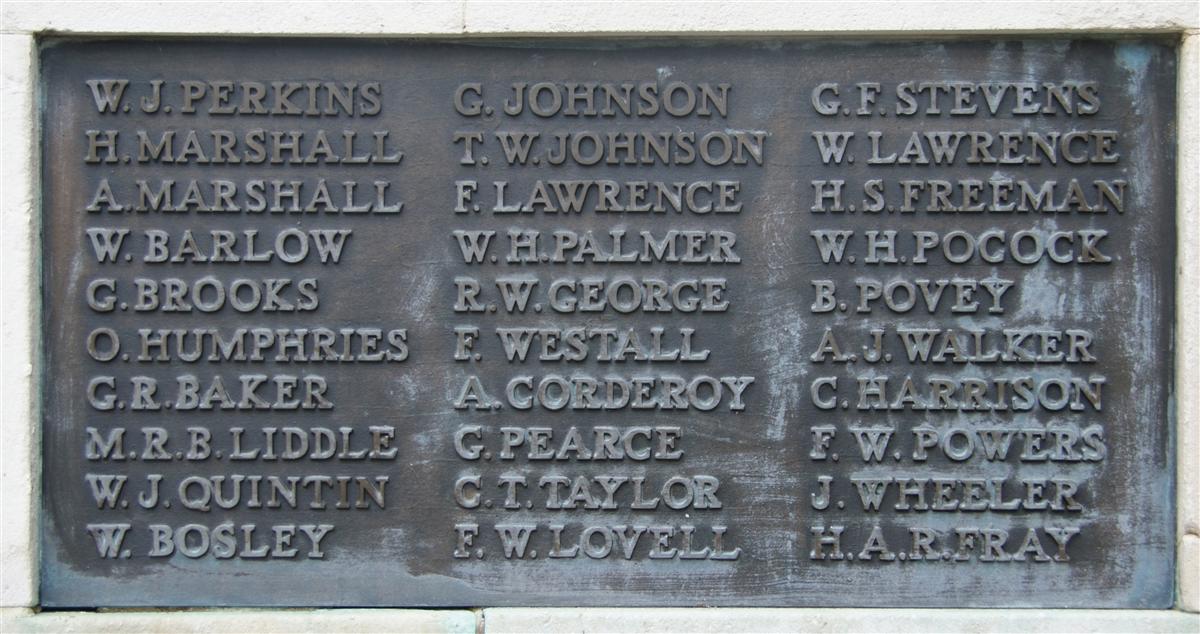
Thomas' name on Newbury War Memorial (right) |
Thomas is buried in grave XXI.A.7 at Gaza War Cemetery – not the easiest cemetery to visit during these troubled times, so a big thank you to Hema Jaradah for taking a picture of Thomas’ grave for this website.
On the anniversary of his death his family remembered him with another In Memoriam notice in the local paper:
Newbury Weekly News, 7 November 1918 – In Memoriam
JOHNSON – In every loving memory of my dear son, Private Thomas Johnson, 15th Hants Regt., who died of wounds in Palestine, November 2nd 1917. – Gone but not forgotten.
With the heroes who sleep on the hillside
He lies with the flag at his head;
But blind with the tears of their weeping,
His loved ones yet mourn for their dead.
The soldier who falls in the battle
May feel but a moment of pain,
But those who wait in the homestead
Must dwell with the ghost of the slain.
Locally he is remembered on Tablet 5 of the Newbury Town War Memorial.
Family
As noted in the newspaper item on Thomas’ death four of his brothers also served in the army during the war.
George died in September 1914 as the war began to turn into the stalemate of trench warfare – his story is told here.
Charles began the war in Gibralter where his battalion, the 2nd Royal Scots Fusiliers, was stationed. It was soon recalled to the UK where it became a part of the 7th Division, which landed in France in October 1914 just in time to play a key role in preventing the Germans from outflanking the French around Ypres. He was probably a part of one of the battalion’s machine gun sections and was transferred to the Machine Gun Corps after it was formed in 1916. However, he may have responded to a call for volunteers to join a new branch of the service – the Heavy Branch of the Machine Gun Corps. These were the men who would enter history at Flers on 15 September 1916 crewing the first tanks. The names of most of the crews at Flers are known, and Charles was not among them, but he was probably in action before the end of the Battle of the Somme in November. He was wounded at some point, probably by the end of 1916, and was invalided out of the army on 28 April 1917. Whilst it would often be immediately obvious that a man would be of no further use to the army they would not usually be discharged before medical treatment had stabilised their condition and they were fit to go home. In time he was able to work as a gardener. It is thought, but not confirmed that he died in the 1950s.
James was the brother who served with the Berkshire Yeomanry at Gallipoli and then in the Camel Corps during the Palestinian campaign (perhaps getting the opportunity to meet Thomas before he died). He survived the war and returned to Newbury where he too worked as a gardener. In 1934 he married Elsie Gilder (formerly Watts) a widow; the couple raised a family in Newbury where James died in 1963 aged 70.
The final brother to serve was William whose service with the Royal Army Medical Corps had proved impossible to isolate as there were numerous William Johnsons in the RAMC.

